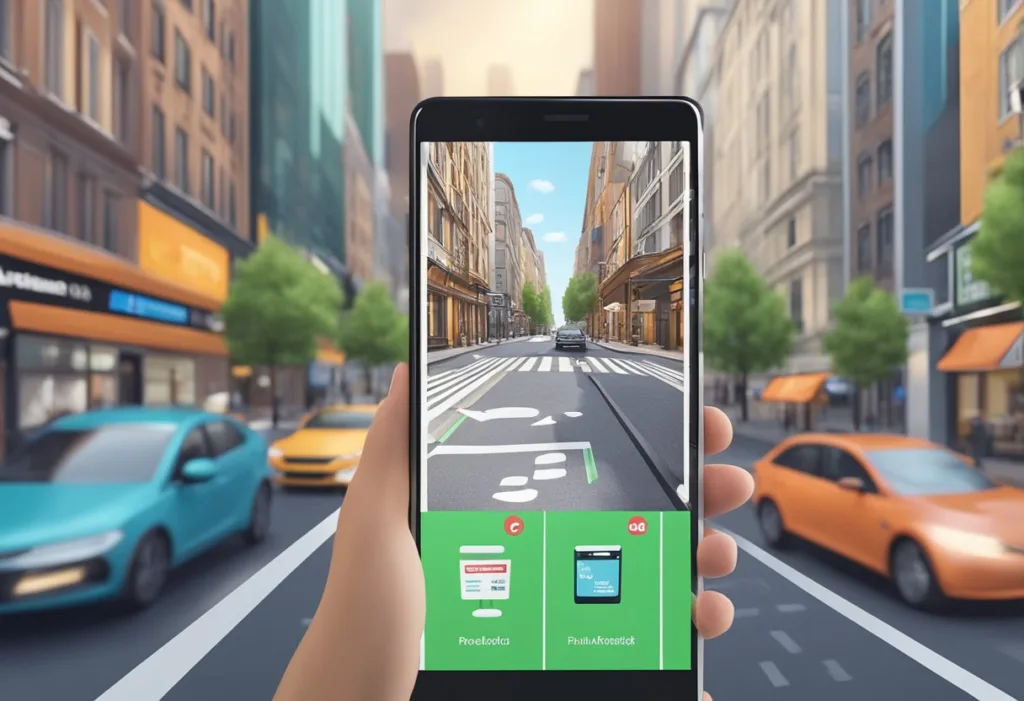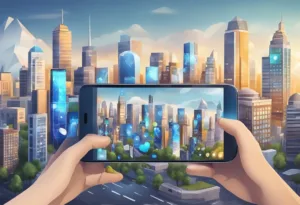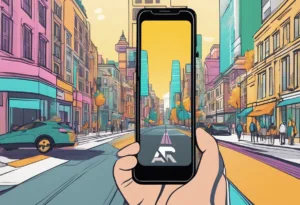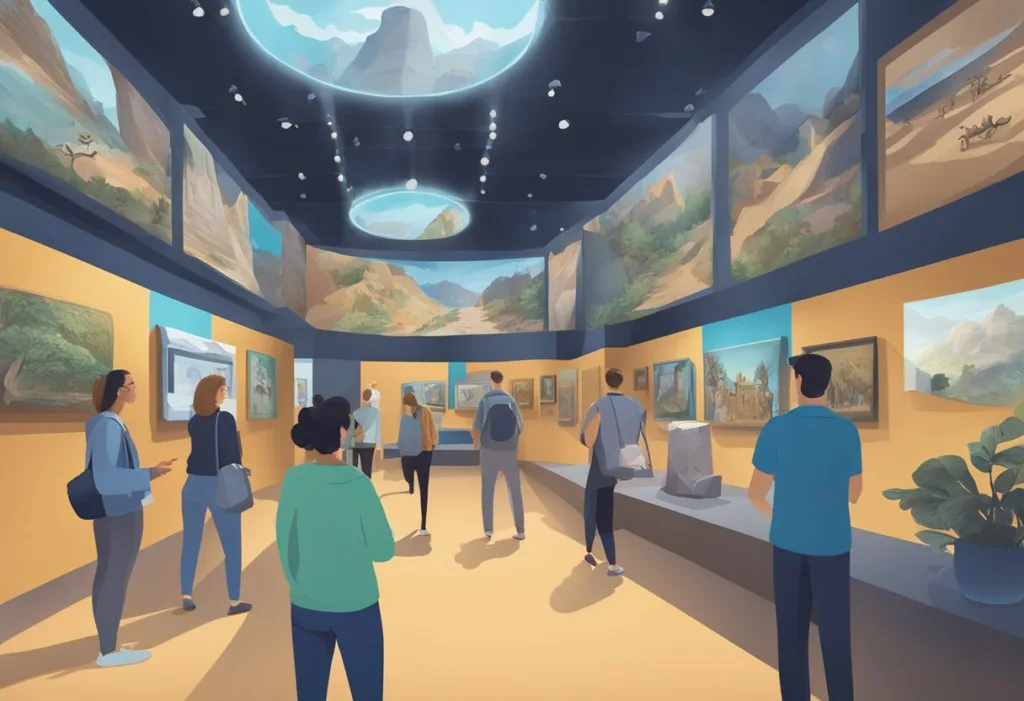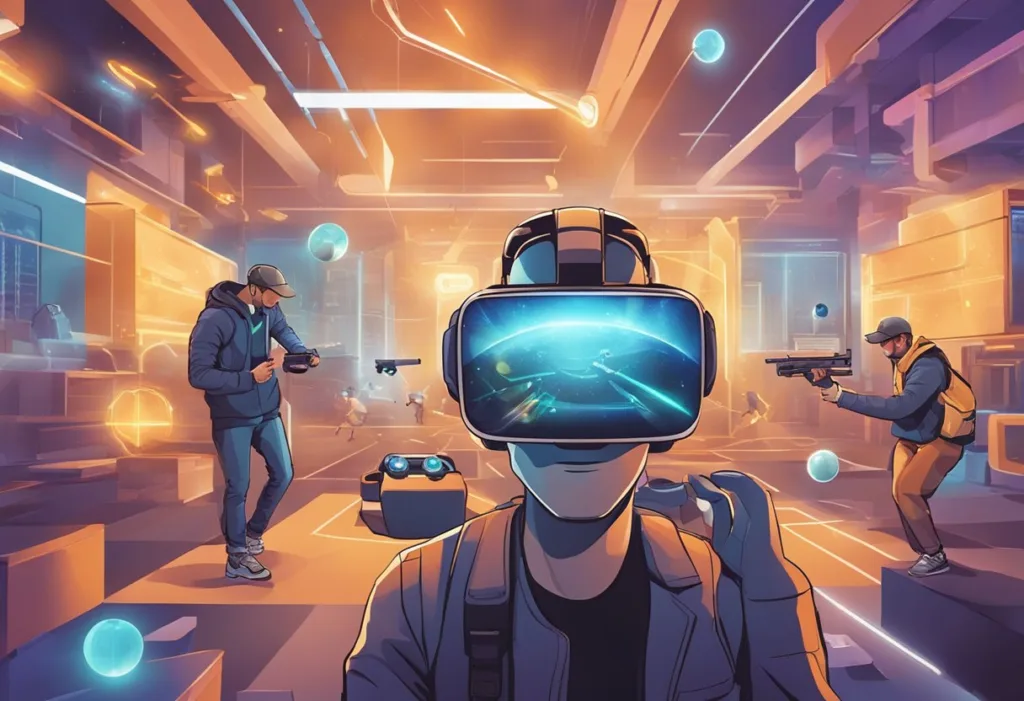Augmented reality (AR) is an innovative technology that has revolutionized the advertising industry. AR advertising has the potential to offer consumers an immersive and interactive experience that traditional advertising cannot deliver. In this article, I will share with you 10 practical augmented reality advertising examples and how can apply them your business.
AR advertising is becoming increasingly popular in retail and e-commerce. Retailers are using AR to create virtual try-on experiences, allowing consumers to see how products will look before they buy them. This technology is also being used to create virtual showrooms where consumers can see how furniture and other products will look in their homes. By using AR in this way, retailers are able to offer consumers a more personalized and engaging experience, increasing the likelihood of a sale.
AR advertising is also being used to leverage branding and PR efforts. Brands are using AR to create unique experiences that engage consumers and create buzz around their products. By using AR in this way, brands are able to differentiate themselves from their competitors and create a more memorable experience for their customers.
What is AR advertising?
Augmented Reality (AR) advertising is a type of advertising that uses AR technology to create interactive experiences for customers. It involves the integration of digital elements into the real world, allowing users to interact with digital content in a physical environment. AR advertising is designed to be immersive, engaging, and memorable, providing users with a unique and unforgettable experience.
How AR advertising works
AR advertising uses a combination of technologies to create a seamless integration between the real world and digital content. It typically involves the use of QR codes, which users can scan with their smartphones to access AR experiences. Once the code is scanned, the user’s device will display digital content that is overlaid onto the real world.
AR advertising can take many forms, including interactive posters, brochures, billboards, and product packaging. It can also be used in experiential marketing campaigns, where brands create immersive experiences to engage with customers.
Role of AR in advertising
AR has become an increasingly important tool for advertisers, as it provides a unique and engaging way to reach customers. By creating immersive AR experiences, brands can capture the attention of their target audience and create a lasting impression. AR advertising can also be used to provide customers with a more personalized experience. By using AR, brands can create customized experiences that are tailored to each individual user’s needs and preferences.
AR advertising is a powerful tool for brands looking to engage with customers in a more meaningful way. By creating immersive, interactive experiences, brands can capture the attention of their target audience and create a lasting impression that will stay with them long after the experience is over.
15 Practical Augmented Reality Advertising Examples
Here’s a list of 15 practical augmented reality advertising examples:
- Lynx
- TG Mag Extra
- Hector&Karger
- Absolut Truths
- IKEA
- Pepsi MAX
- Pizza Hut
- ASOS – ‘See My Fit’
- Pull & Bear – video game
- Burberry – Olympia Pop Up at Harrods
- IKEA Studio app
- Amazon – hair colouring
- L’Oréal
- Adidas
- Gucci
Lynx
Lynx, known for its innovative marketing strategies, leveraged augmented reality to create engaging ads that allowed users to interact with virtual elements overlaid on their real-world environment. One campaign involved an AR-enabled billboard that passersby could interact with, resulting in entertaining and shareable moments. Another company that used a similar approach is Pepsi MAX, which created an AR experience at a bus shelter that made it appear as if extraordinary events, such as alien invasions and tigers roaming the streets, were happening live.
TG Mag Extra
TG Mag Extra, a publication known for its interactive content, utilized AR to enhance the reading experience by bringing the pages to life. Readers could scan images with their smartphones to access additional multimedia content, such as videos and 3D models. Similarly, Pizza Hut incorporated AR into their menus, allowing customers to view animated 3D models of pizzas and play interactive games while waiting for their order.
Hector&Karger
Hector&Karger, a fashion brand, adopted AR to create virtual try-on experiences for their customers. This use of AR allowed shoppers to see how clothes would look on them without physically trying them on. In the same vein, Gucci launched an AR app that let users try on shoes virtually, making it easier for customers to make purchasing decisions from the comfort of their own homes.
Absolut Truths
Absolut Vodka created the “Absolut Truths” campaign, which used AR to share compelling stories about the brand’s history and production process. By scanning Absolut bottles with a smartphone, consumers could unlock these stories and explore them in an immersive way. L’Oréal, a leading cosmetics brand, also utilized AR for their “Makeup Genius” app, which allowed users to try on different makeup looks virtually.
IKEA
IKEA has been at the forefront of AR in retail, with their IKEA Place app allowing customers to visualize furniture in their own space before buying. This helps reduce the uncertainty of online furniture shopping and improves customer satisfaction. Following this example, the IKEA Studio app was developed to provide even more advanced home design features, such as full-room visualization and style recommendations.
Pepsi MAX
Pepsi MAX has consistently used AR to create surprising and delightful experiences for consumers. Their bus shelter campaign is a notable example, where AR was used to make it seem like unbelievable scenarios were unfolding in the real world, capturing the attention of passersby and creating viral content. Similarly, Coca-Cola has used AR in their campaigns, such as their “Magic Mirror” experience in theaters, which allowed moviegoers to see themselves interacting with characters from the film they were about to watch.
Pizza Hut
Pizza Hut leveraged AR technology to make their menu interactive, providing an entertaining experience for customers as they waited for their food. By scanning the menu with a smartphone, customers could play games and see engaging animations. Domino’s also experimented with AR for promotional purposes, offering an AR game that customers could play to win discounts on their orders.
ASOS – ‘See My Fit’
ASOS introduced ‘See My Fit’, an AR feature that allows customers to see how different sized models look in various clothing items, providing a more realistic shopping experience online. This innovation helps customers make better-informed decisions about size and fit. Zara adopted a similar approach by offering AR displays in select stores, where models would come to life on customers’ screens, showcasing the latest collections.
Pull & Bear – video game
Pull & Bear created an AR video game to engage with their younger audience, blending fashion with interactive entertainment. This game could be accessed through their app, providing a fun and unique way to explore the brand’s offerings. Topshop, another fashion retailer, utilized AR in their dressing rooms, allowing customers to try on clothes virtually by standing in front of a digital mirror.
Burberry – Olympia Pop Up at Harrods
Burberry’s Olympia Pop Up at Harrods was an AR experience that transported customers to a virtual recreation of the ancient Greek temple of Olympia, celebrating the launch of their Olympia bag. This immersive experience showcased the craftsmanship and narrative behind the product. Dior also used AR for their pop-up stores, providing an immersive brand experience that included virtual try-on for accessories and a 3D showcase of their collections.
IKEA Studio app
The IKEA Studio app is an evolution of IKEA’s AR offerings, allowing users to design entire rooms with IKEA products. It goes beyond placing individual items, offering wall color changes and floor plan configurations. Home Depot has implemented a similar tool, which helps customers visualize how different products would look and fit in their actual living spaces.
Amazon – hair colouring
Amazon introduced an AR feature that enables customers to virtually try on different hair colors before making a purchase. This interactive experience reduces the risk of dissatisfaction with hair color products. Garnier also provides a virtual hair color try-on feature, allowing customers to experiment with a wide range of shades using their mobile device or computer.
L’Oréal
L’Oréal’s “Makeup Genius” app revolutionized the beauty industry by allowing users to try on makeup virtually using AR technology. This tool helps customers find the right products without physically testing them. Maybelline followed suit with their “Virtual Try-On” feature, which similarly allows customers to experiment with different makeup products and looks.
Adidas
Adidas has embraced AR in their marketing by offering virtual try-on for shoes, giving customers the ability to see how sneakers would look on their feet using their smartphone. Nike also uses AR for shoe try-on, making it easier for customers to make purchase decisions, especially when shopping online.
Gucci
Gucci’s use of AR for virtual try-on extends to their accessory lines, including sunglasses and watches, allowing customers to see how these items would look on them. Ray-Ban also offers an AR try-on experience for sunglasses, helping customers to choose the right style and fit without needing to visit a store.
AR Advertising in Retail and E-commerce
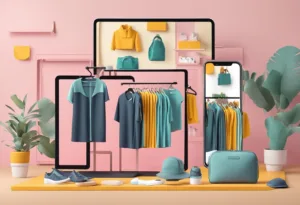
Augmented reality (AR) advertising is becoming increasingly popular in the retail and e-commerce sectors. By using AR technology, retailers can enhance customer experience and increase sales. In this section, we will explore two ways in which AR is being used in retail and e-commerce: virtual try-ons and showrooms and enhancing buyer confidence with AR.
Virtual Try-Ons and Showrooms
Virtual try-ons and showrooms are becoming increasingly popular in the retail industry. By using AR technology, customers can try on clothes, shoes, and accessories virtually before making a purchase. This technology is particularly useful for online retailers who do not have physical stores.
For example, IKEA Place is an app that allows customers to virtually place furniture in their homes to see how it would look before making a purchase. Amazon also has an AR View feature that allows customers to place virtual products in their homes before making a purchase.
Virtual try-ons and showrooms can increase sales as customers are more likely to make a purchase if they can see how the product will look in their own environment. This technology also reduces the number of returns as customers have a better idea of what they are purchasing.
Enhancing Buyer Confidence with AR
AR technology can also enhance buyer confidence in the retail and e-commerce sectors. By using AR technology, customers can see how a product will look in their own environment before making a purchase. This technology is particularly useful for furniture and home decor retailers.
For example, IKEA Place allows customers to virtually place furniture in their homes to see how it would look before making a purchase. This technology can help customers make more informed decisions and reduce the number of returns.
AR technology can also be used to provide customers with more information about a product. For example, customers can scan a product with their smartphone to view information about the product, such as its features and specifications.
AR advertising is becoming increasingly popular in the retail and e-commerce sectors. By using AR technology, retailers can enhance customer experience and increase sales. Virtual try-ons and showrooms and enhancing buyer confidence with AR are just two ways in which AR is being used in the retail and e-commerce sectors.
Leveraging AR for Branding and PR
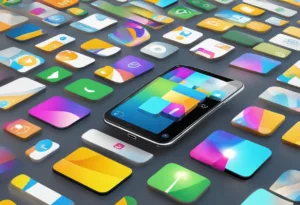
Augmented Reality (AR) is transforming the way brands approach advertising and public relations (PR). By creating unique brand experiences, companies can leave a lasting impression on their target audience and generate buzz on social media. In this section, we will explore how brands are leveraging AR for their branding and PR efforts.
Creating Unique Brand Experiences
One of the primary benefits of AR is its ability to create immersive and engaging experiences for consumers. Brands can leverage AR to showcase their products in a unique and interactive way, allowing consumers to explore and engage with them in a way that was previously impossible.
For example, Gucci launched an AR-powered app that allowed users to try on virtual shoes and see how they looked in real life. Pepsi created an AR experience that allowed users to interact with a virtual vending machine and win prizes. Adidas used AR to create an interactive in-store experience that allowed customers to see how their shoes would look on the field.
Case Studies: Pepsi, Gucci, and Adidas
Pepsi’s “Uncap the Ultimate Prize” campaign was a huge success, generating over 6 million impressions on social media and driving sales. The campaign allowed users to interact with a virtual vending machine and win prizes, creating a unique and engaging experience that resonated with consumers.
Gucci’s AR-powered app, “Try On”, allowed users to try on virtual shoes and see how they looked in real life. The app was a hit with consumers, generating over 2 million downloads and driving sales for the brand. Adidas used AR to create an interactive in-store experience that allowed customers to see how their shoes would look on the field. The experience was a hit with customers, driving sales and generating buzz on social media.
Integrating AR with Social Media Marketing
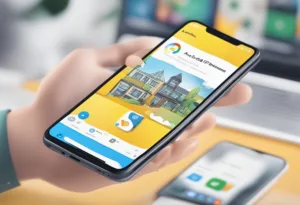
If you’re looking to create an interactive experience for your customers, integrating augmented reality (AR) into your social media marketing strategy is a great way to do so. By using AR filters and effects on social media platforms such as Snapchat and Instagram, you can create an engaging and memorable experience for your audience.
Snapchat and Instagram as AR Platforms
Snapchat and Instagram are two of the most popular social media platforms for AR marketing. Both platforms offer AR filters and effects that allow users to interact with your brand in a unique way.
Snapchat’s AR lenses are a great way to create interactive experiences for your customers. These lenses can be used to create fun and engaging experiences that users can share with their friends. For example, you can create a lens that allows users to try on virtual makeup or accessories, or a lens that transforms their face into a cartoon character.
Instagram’s AR filters are another great way to create interactive experiences for your customers. These filters can be used to create fun and engaging experiences that users can share with their followers. For example, you can create a filter that allows users to try on virtual sunglasses or hats, or a filter that adds a virtual background to their photos.
The Virality of AR Filters and Effects
One of the biggest benefits of using AR filters and effects on social media is their virality. When users share your AR filters and effects with their friends and followers, they’re essentially promoting your brand for you. This can lead to increased brand awareness and engagement.
In addition to promoting your brand, AR filters and effects can also be used to drive traffic to your website or social media profiles. For example, you can create a filter that includes a call-to-action (CTA) that encourages users to visit your website or follow your social media profiles.
Integrating AR with social media marketing is a great way to create an interactive and engaging experience for your customers. By using AR filters and effects on platforms such as Snapchat and Instagram, you can increase brand awareness, engagement, and drive traffic to your website or social media profiles.
Measuring the Success of AR Advertising
Augmented Reality (AR) advertising is a rapidly growing field, with more and more companies adopting it as part of their marketing strategies. But how do you measure the success of your AR campaign? In this section, we will explore some of the ways you can measure the ROI of your AR advertising campaign.
Analytics and ROI in AR Campaigns
One of the most important aspects of measuring the success of an AR campaign is tracking the analytics. By tracking the number of impressions, engagement rates, and conversions, you can get a better understanding of how successful your campaign has been.
For instance, Maybelline paired their Lifter Gloss campaign with an original song on TikTok, which helped them to reach a wider audience and generate more impressions. Similarly, IKEA’s Place Tool allowed customers to virtually place furniture in their homes, which resulted in a higher engagement rate and more conversions.
Another way to measure the ROI of your AR campaign is to track the sales generated from the campaign. By tracking the sales, you can get a better understanding of the revenue generated from the campaign and calculate the ROI.
Future Trends in AR Advertising
As the AR market continues to grow, we can expect to see more advanced analytics tools being developed. For instance, AI-powered analytics tools can help to provide more accurate data and insights, which can help companies to optimize their campaigns and improve their ROI.
Moreover, we can expect to see more interactive and immersive AR experiences being developed, which can help to increase engagement rates and conversions. For instance, Coca-Cola’s AR campaign allowed customers to interact with a virtual vending machine, which resulted in a higher engagement rate and more conversions.
Measuring the success of your AR campaign is essential to optimizing your marketing strategies and generating a higher ROI. By tracking the analytics and sales generated from the campaign, you can get a better understanding of how successful your campaign has been. And as the AR market continues to grow, we can expect to see more advanced analytics tools and immersive AR experiences being developed.
Frequently Asked Questions
How are companies integrating augmented reality into their marketing strategies?
Augmented reality (AR) is gaining popularity among companies, and they are integrating it into their marketing strategies in various ways. One of the most common ways is through mobile apps that allow consumers to interact with products in a virtual environment. Companies are also using AR in experiential marketing campaigns, such as pop-up stores, to create an immersive experience for customers. AR is also being used in print advertising, where consumers can scan a print ad with their mobile device to access additional content or a virtual experience.
What are some successful augmented reality campaigns by major brands?
Major brands have successfully implemented AR campaigns in recent years. One example is the IKEA Place app, which allows users to virtually place furniture in their home before purchasing. This app has increased online sales by 35% since its inception. Another example is the Pokémon Go game, which took the world by storm in 2016 and was one of the most notable AR experiences. Burberry created an AR experience in their Harrods pop-up store, where customers could interact with virtual versions of their products.
Can you provide examples of augmented reality in print advertising?
AR in print advertising is becoming more common, and some brands are using it to create interactive experiences for consumers. For example, the car manufacturer Audi created an AR print ad that allowed users to view a virtual version of their car. Another example is the AR-enabled cover of the Sports Illustrated magazine, which allowed users to view a 3D version of a football player.
What innovative approaches to AR advertising emerged in recent years?
One innovative approach to AR advertising is through the use of location-based AR experiences. For example, the app called “The Walking Dead: Our World” allows users to fight virtual zombies that are superimposed on the real world. Another approach is the use of AR in social media filters, such as the Snapchat filters that allow users to add virtual objects to their photos and videos.
How does augmented reality enhance consumer engagement in advertising?
AR enhances consumer engagement in advertising by creating an immersive and interactive experience for the consumer. This allows the consumer to better understand the product and its features, which can lead to increased brand loyalty and sales. AR also allows for more personalized marketing, as the consumer can interact with the product in a virtual environment that is tailored to their preferences.
What are the benefits of using augmented reality for business promotions?
The benefits of using AR for business promotions include increased brand awareness, higher engagement rates, and improved customer experiences. AR can also lead to increased sales and reduced product returns, as consumers can better understand the product before making a purchase. AR can provide valuable data insights for businesses, such as consumer behavior and preferences.

